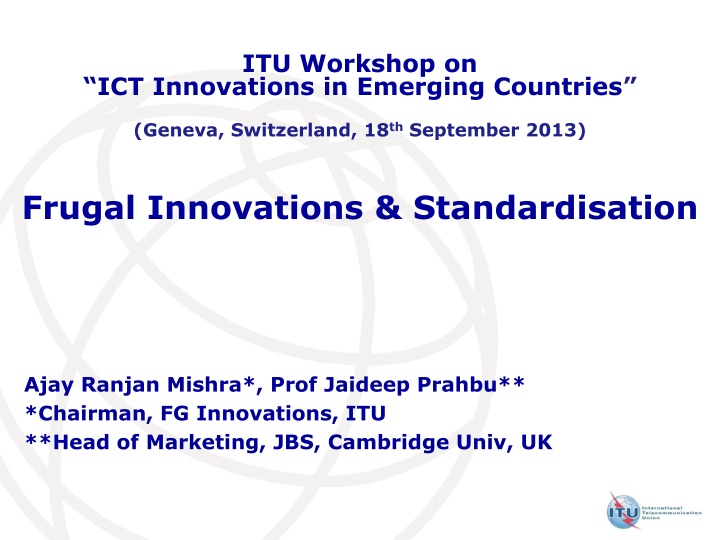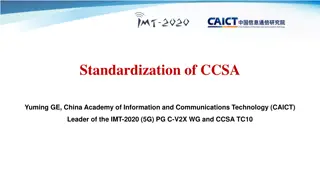Impact of Standardization on Economic Growth in Emerging Countries
Standardization plays a crucial role in the economic growth of emerging countries by contributing significantly to GDP growth and labor productivity. Case studies from countries like Germany, UK, Canada, and Australia highlight the positive impact of standards on innovation and overall economic performance. Furthermore, insights from the Global Innovation Index showcase the top countries excelling in innovation across various factors. The case study of Kenya demonstrates the transformative power of mobile money innovations in driving social and economic empowerment.
Download Presentation

Please find below an Image/Link to download the presentation.
The content on the website is provided AS IS for your information and personal use only. It may not be sold, licensed, or shared on other websites without obtaining consent from the author.If you encounter any issues during the download, it is possible that the publisher has removed the file from their server.
You are allowed to download the files provided on this website for personal or commercial use, subject to the condition that they are used lawfully. All files are the property of their respective owners.
The content on the website is provided AS IS for your information and personal use only. It may not be sold, licensed, or shared on other websites without obtaining consent from the author.
E N D
Presentation Transcript
ITU Workshop on ICT Innovations in Emerging Countries (Geneva, Switzerland, 18th September 2013) Frugal Innovations & Standardisation Ajay Ranjan Mishra*, Prof Jaideep Prahbu** *Chairman, FG Innovations, ITU **Head of Marketing, JBS, Cambridge Univ, UK
Impact of Standardization Standards contribute at least as much as patents to economic growth The macroeconomic benefits of standardization exceed the benefits to companies alone 2
Case Studies Standards Impacting GDP GERMANY: Between 1961 to 1990 capital contribution is 1.6 percentage points per annum while the standards contribute 0.9 percentage points per annum towards a growth rate of 3.3%, while here the contribution from patents is modest. UK: Growth in the standards catalogue over the period 1948 - 2002 contributed about 13% (one seventh) of the growth in labour productivity in the UK experienced over that period. GDP grew by 2.5% per year over that period. Of course innovations played an important role in these figures. CANADA: Study over a period of 1981-2004 showed that standardization accounted for 17 per cent of the growth rate in labour productivity which translates into approximately 9 per cent of the growth rate in real GDP. Australia: Over the 40 years to 2002, a 1 percent increase in the number of Australian Standards is associated with a 0.17 per cent increase in productivity across the economy. These figures are far higher to that of UK/ Europe etc 3
Innovations: Insights from GII INSEAD Business schools Global Innovation Index rates following top ten countries as innovation hotbeds. 1. US, 2. Germany, 3. Sweden, 4. UK, 5. Singapore, 6. South Korea, 7. Switzerland, 8. Denmark, 9. Japan, 10. Netherlands The study takes into account following factors: Institutions, Human capacity, Infrastructure, Markets and Business sophistication 4
Innovations to $: Case Study Kenya There are approximately 60 million mobile money users in the world - almost one in three is a Kenyan. Half of all mobile money transactions are taking place in Kenya where annual transfers are now around US$ 10 billon The emerging social and economic impact has been remarkable. Shop-owners don t need to carry a lot of cash, or to stand in long queues at Banks to transfer money to suppliers. Urban dwellers no longer need to make overnight trips to their rural homes to pay their children s school fees (or give money to relatives). Women have been empowered because their husbands have a harder time taking their money away. Even macroeconomic policy has become easier because the Central Bank has a better handle on the money in circulation, as mobile money helped to move cash from the mattresses to the market 6
Why MPESA was a failure outside Kenya? REGULATORY: First, Kenya s regulators enabled the mobile money take-off. The Central Bank in particular played a very progressive role and allowed regulation to follow innovation , while reassuring the market of its oversight. OPERATOR: Second, the strategy of the omnipresent operator Safaricom was also important ihas more than 50% market share. STRATEGY FOCUS PEOPLE MANAGEMENT: Safaricom s management understood that the success of M-PESA was ultimately about people management, not technology. Many innovations fail because management focuses exclusively on designing and launching a product, and assume that technology will take care of itself afterwards. The opposite is true. You need people to run machines and the interactions you get after product launch can generate even better products. The true secret of M- PESA s success is the management of the agent network, which grew from 300 initially to almost 30,000 today. 7
Analysis & Conclusion None of the developing countries come in top 10 though developing countries are considered places where innovation is happening 10% increase in connectivity leads to~1% growth in GDP Why is not there a more growth in GDP with connectivity? 8























